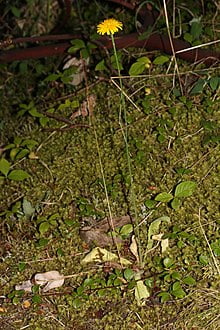Hypochaeris radicata

Hypochaeris radicata (sometimes spelled Hypochoeris radicata) – also known as catsear, flatweed,[1][2] cat’s-ear,[3] hairy cat’s ear,[4] or false dandelion – is a perennial, low-lying edible herb often found in lawns. The plant is native to Europe,[5] but has also been introduced to the Americas,[6][7][8] Japan,[9] Australia,[10] and New Zealand, where it can be an invasive weed. It is listed as a noxious weed in the northwestern U.S. state of Washington.[11]
Its name is derived from Greek ὑπό (under) and χοῖρος (young pig). Thus the name should be spelled Hypochoeris. The adjective radicata means with conspicuous roots in Latin (derived from radix, root).
In English, Catsear is derived from the words cat’s ear, and refers to the shape and fine hair on the leaves resembling that of the ear of a cat.
The plant is also known as “false dandelion”, as it is commonly mistaken for true dandelions. Both plants carry similar flowers which form windborne seeds. However, catsear flowering stems are forked and solid, whereas dandelions possess unforked stems that are hollow. Both plants have a rosette of leaves and a central taproot. The leaves of dandelions are jagged in appearance, whereas those of catsear are more lobe-shaped and hairy. Both plants have similar uses.
